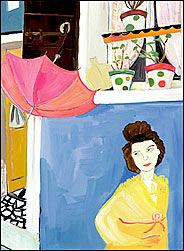Mellifluous punctuation and somebody else’s umbrella
«The Elements of Style» de William Strunk et E.B. White est, en plus court, à l’anglais américain ce qui est le Grevisse au français. Toute une frange des anglophones instruits, dont un certain nombre de profs, ne jurent que par ce manuel de style et de grammaire.
Malheureusement, les auteurs ont poussé le stalinisme grammatical au point de proscrire des tournures utilisées par les plus grands écrivains depuis des siècles, et s’avèrent occasionnellement incapables de suivre leurs propres conseils. Certains donc, et pas les moindres, vouent le livre aux gémonies et n’ont qu’un désir : qu’il n’eusse jamais été écrit.
Maintenant, une version illustrée par une dessinatrice et auteure de livres pour enfants et un cycle de chants par un jeune compositeur néo-dadaiste font leur apparence sur ce champs de bataille grammaticale et stylistique.
I imagine Geoffrey Pullum has a file on his computer named “Strunk and White adjectives”, and every time he posts about The Elements of Style he chooses a new one and ticks it off as “used”. He’s called the opus a horrid little notebook of nonsense, a stupid little book, a poisonous little collection of bad grammatical advice, a horrid little compendium of unmotivated prejudices, a toxic little book of crap, a disgusting little atavistic compendium of falsehoods, a pox-ridden little pocketbook of pointless pontifications — and that’s where I stopped searching. (Do I sense an attempt to create a snowclone here, by the way?)

An illustrated version could only be an improvement, then, right? In particular if the pictures are, as David Gelernter puts it in the Opinion Journal, “bright, jazzy, irrelevant” and show that Maira Kalman, the illustrator, fundamentally strayed from the book’s dictum of “keeping things plain and simple”: Take that, Strunk! Serves you right, White!
Jeremy Eichler’s review in today’s New York Times has more. The illustrations aren’t even attempting to illustrate rules of grammar and usage. They riff on the visual quality of the book’s example sentences — which are apparently#[1] about as natural as those your typical EFL textbook uses — and occasionally on Strunk or White’s own prose. This might be entirely appropriate: I can’t see how “Be obscure clearly” would help me improve my “weak and flabby prose”#[2], but the sentence does take my visual fancy.
Still, the following passage, which I read very late last night, had me check I wasn’t suffering from caffeine-induced hallucinations:
She explained that while she was painting her illustrations, she found herself singing the words and dreaming of a Strunk and White opera, or even a ballet. She turned to Mr. Muhly, whom she had known for more than a decade as a family friend and co-conspirator in various neo-Dadaist adventures. (Ms. Kalman once ran a Rubber Band Society - for people who love rubber bands, naturally - and invited Mr. Muhly to compose a work scored for rubber bands, which he did.) “I knew that Nico and I would have an immediate conversation in shorthand about humor and imagination, and that he’d completely get it,” Ms. Kalman said.
Mr. Muhly, 24, is a talented and audacious graduate of the Juilliard School who has worked with Philip Glass and Bjork. His Strunk and White songs are eloquently scored for soprano, tenor, viola, banjo and percussion. They also include parts for Ms. Kalman’s friends and family, who will make “little gentle noises” through amplified kitchen utensils (vintage eggbeaters and meat grinders) and a set of dice shaken in a bowl.
I’m torn, I admit. On the one hand, that’s a lovely idea. A neo-Dadaist song cycle is probably exactly what the book needs#[3], a way to desecrate this Monument of American Culture. But on the other hand, if Mr Muhly’s song cycle has any success, it could also serve to perpetuate Strunk and White’s style and grammar advice. Which I don’t think would be helpful, really.
UPDATE: On the site of the NY Public Library, more on THE ELEMENTS OF STYLE: A Short Happy Evening of Song with Maira Kalman and Nico Muhly, which is being performed about now. Dixit the library:
With titles such as “Be Obscure Clearly!”, “Overly Over,” and “Hyphens,” the songs are drawn from the humorous examples of poor writing and the pithy rules for proper grammar found in The Elements of Style.
There’s also a pretty picture of the soprano Abby Fischer.
UPDATE2: Embarrassing misspelling corrected.
[1]: I don’t own the book and rely on the language blogosphere on this; if Prof. Pullum’s stance seems particularly radical, I’ve rarely seen much good said about the book, and even the most sympathetic language bloggers call it outdated. But I was sorely tempted to go out and look for a used copy when I learned that Strunk and White forbid the use of people as a plural form for person when the word is preceded by a number. That bit was too crazy for me to stomach. English native speakers, I’ll tell you a secret: it’s taught that way in EFL classes all over the world, though I’ve personally stopped short of calling people the actual plural of person — some do, but that’s just not right — like in mouse, mice or child, children. Update: It hadn’t occurred to me that there’s a copy available on Bartleby.com. [2]: Jeremy Eichler’s words, which appear in the same sentence as “split infinitives” and “dangling participles”, sigh. He’s considerable more pro-Elements than the conventional linguablogospheric wisdom has it. [3]: Let’s not forget that Dadaism was a reaction to utter despair.
Related posts: Amuse-bouche to zaibatsu, Nouns and verbs on #wordpress, A relative clause there'll have to be some thinking over, Reading, Reading Little Women, Dangling relative clause, Confusing hedges
Technorati (tags): anglais, books, English, grammar, language, Strunk and White, style


The article also mentions a ballet based on “Elements of Style.” Dangling participle personified…